Copper
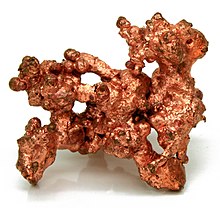 | |||||||||||||||||||||||||||||||||
| Copper | |||||||||||||||||||||||||||||||||
|---|---|---|---|---|---|---|---|---|---|---|---|---|---|---|---|---|---|---|---|---|---|---|---|---|---|---|---|---|---|---|---|---|---|
| Appearance | Red-orange metallic luster | ||||||||||||||||||||||||||||||||
| Standard atomic weight Ar°(Cu) | |||||||||||||||||||||||||||||||||
| Copper in the periodic table | |||||||||||||||||||||||||||||||||
| |||||||||||||||||||||||||||||||||
kJ/mol | |||||||||||||||||||||||||||||||||
| Heat of vaporization | 300.4 kJ/mol | ||||||||||||||||||||||||||||||||
| Molar heat capacity | 24.440 J/(mol·K) | ||||||||||||||||||||||||||||||||
Vapor pressure
| |||||||||||||||||||||||||||||||||
| Atomic properties | |||||||||||||||||||||||||||||||||
9000 BC) | |||||||||||||||||||||||||||||||||
| Symbol | "Cu": from Latin cuprum | ||||||||||||||||||||||||||||||||
| Isotopes of copper | |||||||||||||||||||||||||||||||||
| |||||||||||||||||||||||||||||||||
Copper is a
Copper is one of the few metals that can occur in nature in a directly usable metallic form (native metals). This led to very early human use in several regions, from c. 8000 BC. Thousands of years later, it was the first metal to be smelted from sulfide ores, c. 5000 BC; the first metal to be cast into a shape in a mold, c. 4000 BC; and the first metal to be purposely alloyed with another metal, tin, to create bronze, c. 3500 BC.[8]
In the Roman era, copper was mined principally on Cyprus, the origin of the name of the metal, from aes cyprium (metal of Cyprus), later corrupted to cuprum (Latin). Coper (Old English) and copper were derived from this, the later spelling first used around 1530.[9]
Commonly encountered compounds are copper(II) salts, which often impart blue or green colors to such minerals as azurite, malachite, and turquoise, and have been used widely and historically as pigments.
Copper used in buildings, usually for roofing, oxidizes to form a green
Copper is essential to all living organisms as a trace
Characteristics
Physical

Copper,
The softness of copper partly explains its high electrical conductivity (59.6×106 S/m) and high thermal conductivity, second highest (second only to silver) among pure metals at room temperature.[14] This is because the resistivity to electron transport in metals at room temperature originates primarily from scattering of electrons on thermal vibrations of the lattice, which are relatively weak in a soft metal.[12] The maximum possible current density of copper in open air is approximately 3.1×106 A/m2, above which it begins to heat excessively.[15]
Copper is one of a few metallic elements with a natural color other than gray or silver.
As with other metals, if copper is put in contact with another metal in the presence of an electrolyte, galvanic corrosion will occur.[18]
Chemical


Copper does not react with water, but it does slowly react with atmospheric oxygen to form a layer of brown-black copper oxide which, unlike the rust that forms on iron in moist air, protects the underlying metal from further corrosion (passivation). A green layer of verdigris (copper carbonate) can often be seen on old copper structures, such as the roofing of many older buildings[19] and the Statue of Liberty.[20] Copper tarnishes when exposed to some sulfur compounds, with which it reacts to form various copper sulfides.[21]
Isotopes
There are 29
Cu
with a half-life of 61.83 hours.[22] Seven metastable isomers have been characterized; 68m
Cu
is the longest-lived with a half-life of 3.8 minutes. Isotopes with a mass number above 64 decay by β−, whereas those with a mass number below 64 decay by β+. 64
Cu
, which has a half-life of 12.7 hours, decays both ways.[23]
62
Cu
and 64
Cu
have significant applications. 62
Cu
is used in 62
Cu
Cu-PTSM as a radioactive tracer for positron emission tomography.[24]
Occurrence

Copper is produced in massive stars
Typical background concentrations of copper do not exceed 1 ng/m3 in the atmosphere; 150 mg/kg in soil; 30 mg/kg in vegetation; 2 μg/L in freshwater and 0.5 μg/L in seawater.[29]
Production
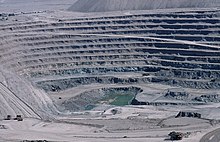
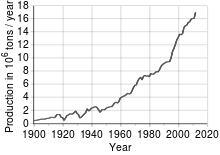
Most copper is mined or
Reserves and prices
Copper has been in use for at least 10,000 years, but more than 95% of all copper ever mined and smelted has been extracted since 1900.[33] As with many natural resources, the total amount of copper on Earth is vast, with around 1014 tons in the top kilometer of Earth's crust, which is about 5 million years' worth at the current rate of extraction. However, only a tiny fraction of these reserves is economically viable with present-day prices and technologies. Estimates of copper reserves available for mining vary from 25 to 60 years, depending on core assumptions such as the growth rate.[34] Recycling is a major source of copper in the modern world.[33]

The price of copper is volatile.[35] After a peak in 2022 the price unexpectedly fell.[36]
Methods

The great majority of copper ores are sulfides. Common ores are the sulfides chalcopyrite (CuFeS2), bornite (Cu5FeS4) and, to a lesser extent, covellite (CuS) and chalcocite (Cu2S).[37] These ores occur at the level of <1% Cu. Concentration of the ore is required, which begins with comminution followed by froth flotation. The remaining concentrate is the smelted, which can be described with two simplified equations: [38]
- 2 Cu2S + 3 O2 → 2 Cu2O + 2 SO2
Cuprous oxide reacts with cuprous sulfide to convert to blister copper upon heating
- 2 Cu2O + Cu2S → 6 Cu + 2 SO2
This roasting gives matte copper, roughly 50% Cu by weight, which is purified by electrolysis. Depending on the ore, sometimes other metals are obtained during the electrolysis including platinum and gold.
Aside from sulfides, another family of ores are oxides. Approximately 15% of the world's copper supply derives from these oxides. The beneficiation process for oxides involves extracton with sulfuric acid solutions followed by electrolysis. In parallel with the above method for "concentrated" sulfide and oxide ores, copper is recovered from mine tailings and heaps. A variety of methods are used including leaching with sulfuric acid, ammonia, ferric chloride. Biological methods are also used.[38][39]
A significant source of copper is from recycling. Recycling is facilitated because copper is usually deployed in its metallic state. In 2001, a typical automobile contained 20–30 kg of copper. Recycling usually begins with some melting process using a blast furnace.[38]
A potential source of copper is polymetallic nodules, which have an estimated concentration 1.3%.[40][41]
- Blister copper
- Smelting
- Reverberatory furnace
- Slag removal
- Copper casting of anodes
- Casting wheel
- Anodes removal machine
- Anodes take-off
- Rail cars
- Transportation to the tank house

Recycling
Like aluminium, copper is recyclable without any loss of quality, both from raw state and from manufactured products.[42] In volume, copper is the third most recycled metal after iron and aluminium.[43] An estimated 80% of all copper ever mined is still in use today.[44] According to the International Resource Panel's Metal Stocks in Society report, the global per capita stock of copper in use in society is 35–55 kg. Much of this is in more-developed countries (140–300 kg per capita) rather than less-developed countries (30–40 kg per capita).
The process of recycling copper is roughly the same as is used to extract copper but requires fewer steps. High-purity scrap copper is melted in a
Environmental impacts
The environmental cost of copper mining was estimated at 3.7 kg
Copper mining waste in Valea Şesei, Romania, has significantly altered nearby water properties. The water in the affected areas is highly acidic, with a pH range of 2.1–4.9, and shows elevated electrical conductivity levels between 280 and 1561 mS/cm.[49] These changes in water chemistry make the environment inhospitable for fish, essentially rendering the water uninhabitable for aquatic life.
Alloys

Numerous copper alloys have been formulated, many with important uses. Brass is an alloy of copper and zinc. Bronze usually refers to copper-tin alloys, but can refer to any alloy of copper such as aluminium bronze. Copper is one of the most important constituents of silver and karat gold solders used in the jewelry industry, modifying the color, hardness and melting point of the resulting alloys.[52] Some lead-free solders consist of tin alloyed with a small proportion of copper and other metals.[53]
The alloy of copper and nickel, called cupronickel, is used in low-denomination coins, often for the outer cladding. The US five-cent coin (currently called a nickel) consists of 75% copper and 25% nickel in homogeneous composition. Prior to the introduction of cupronickel, which was widely adopted by countries in the latter half of the 20th century,[54] alloys of copper and silver were also used, with the United States using an alloy of 90% silver and 10% copper until 1965, when circulating silver was removed from all coins with the exception of the half dollar—these were debased to an alloy of 40% silver and 60% copper between 1965 and 1970.[55] The alloy of 90% copper and 10% nickel, remarkable for its resistance to corrosion, is used for various objects exposed to seawater, though it is vulnerable to the sulfides sometimes found in polluted harbors and estuaries.[56] Alloys of copper with aluminium (about 7%) have a golden color and are used in decorations.[26] Shakudō is a Japanese decorative alloy of copper containing a low percentage of gold, typically 4–10%, that can be patinated to a dark blue or black color.[57]
Compounds
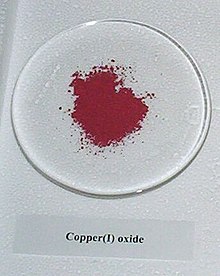
Copper forms a rich variety of compounds, usually with oxidation states +1 and +2, which are often called cuprous and cupric, respectively.[58] Copper compounds promote or catalyse numerous chemical and biological processes.[59]
Binary compounds
As with other elements, the simplest compounds of copper are binary compounds, i.e. those containing only two elements, the principal examples being oxides, sulfides, and halides. Both cuprous and cupric oxides are known. Among the numerous copper sulfides,[60] important examples include copper(I) sulfide (Cu2S) and copper monosulfide (CuS).[61]
Cuprous halides with fluorine, chlorine, bromine, and iodine are known, as are cupric halides with fluorine, chlorine, and bromine. Attempts to prepare copper(II) iodide yield only copper(I) iodide and iodine.[58]
- 2 Cu2+ + 4 I− → 2 CuI + I2
Coordination chemistry

Copper forms coordination complexes with ligands. In aqueous solution, copper(II) exists as [Cu(H
2O)
6]2+
. This complex exhibits the fastest water exchange rate (speed of water ligands attaching and detaching) for any transition metal aquo complex. Adding aqueous sodium hydroxide causes the precipitation of light blue solid copper(II) hydroxide. A simplified equation is:
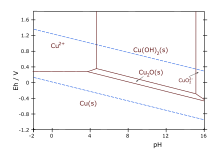
- Cu2+ + 2 OH− → Cu(OH)2
Aqueous ammonia results in the same precipitate. Upon adding excess ammonia, the precipitate dissolves, forming tetraamminecopper(II):
- Cu(H
2O)
4(OH)
2 + 4 NH3 → [Cu(H
2O)
2(NH
3)
4]2+
+ 2 H2O + 2 OH−
Many other oxyanions form complexes; these include copper(II) acetate, copper(II) nitrate, and copper(II) carbonate. Copper(II) sulfate forms a blue crystalline pentahydrate, the most familiar copper compound in the laboratory. It is used in a fungicide called the Bordeaux mixture.[62]
Organocopper chemistry
Compounds that contain a carbon-copper bond are known as organocopper compounds. They are very reactive towards oxygen to form copper(I) oxide and have
Copper(III) and copper(IV)
Copper(III) is most often found in oxides. A simple example is potassium
Some copper proteins form
Complexes of copper(III) are also found as intermediates in reactions of organocopper compounds, for example in the Kharasch–Sosnovsky reaction.[80][81][82]
History
A timeline of copper illustrates how this metal has advanced human civilization for the past 11,000 years.[83]
Prehistoric
Copper Age
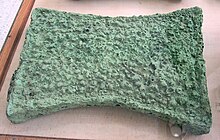
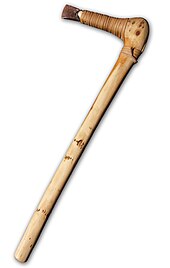

Copper occurs naturally as
Copper smelting was independently invented in different places. It was probably discovered in China before 2800 BC, in Central America around 600 AD, and in West Africa about the 9th or 10th century AD.
Production in the
Bronze Age
Natural bronze, a type of copper made from ores rich in silicon, arsenic, and (rarely) tin, came into general use in the Balkans around 5500 BC.
The Bronze Age began in Southeastern Europe around 3700–3300 BC, in Northwestern Europe about 2500 BC. It ended with the beginning of the Iron Age, 2000–1000 BC in the Near East, and 600 BC in Northern Europe. The transition between the Neolithic period and the Bronze Age was formerly termed the Chalcolithic period (copper-stone), when copper tools were used with stone tools. The term has gradually fallen out of favor because in some parts of the world, the Chalcolithic and Neolithic are coterminous at both ends. Brass, an alloy of copper and zinc, is of much more recent origin. It was known to the Greeks, but became a significant supplement to bronze during the Roman Empire.[102]
Ancient and post-classical

In Greece, copper was known by the name chalkos (χαλκός). It was an important resource for the Romans, Greeks and other ancient peoples. In Roman times, it was known as aes Cyprium, aes being the generic Latin term for copper alloys and Cyprium from
Copper was first mined in ancient Britain as early as 2100 BC. Mining at the largest of these mines, the Great Orme, continued into the late Bronze Age. Mining seems to have been largely restricted to supergene ores, which were easier to smelt. The rich copper deposits of Cornwall seem to have been largely untouched, in spite of extensive tin mining in the region, for reasons likely social and political rather than technological.[105]
In North America, native copper is known to have been extracted from sites on Isle Royale with primitive stone tools between 800 and 1600 AD.[106] Copper annealing was being performed in the North American city of Cahokia around 1000–1300 AD.[107] There are several exquisite copper plates, known as the Mississippian copper plates that have been found in North America in the area around Cahokia dating from this time period (1000–1300 AD).[107] The copper plates were thought to have been manufactured at Cahokia before ending up elsewhere in the Midwest and southeastern United States like the Wulfing cache and Etowah plates.
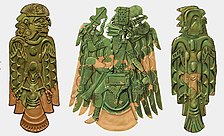
In South America a copper mask dated to 1000 BC found in the Argentinian Andes is the oldest known copper artifact discovered in the Andes.[108] Peru has been considered the origin for early copper metallurgy in pre-Columbian America, but the copper mask from Argentina suggests that the Cajón del Maipo of the southern Andes was another important center for early copper workings in South America.[108] Copper metallurgy was flourishing in South America, particularly in Peru around 1000 AD. Copper burial ornamentals from the 15th century have been uncovered, but the metal's commercial production did not start until the early 20th century.[citation needed]
The cultural role of copper has been important, particularly in currency. Romans in the 6th through 3rd centuries BC used copper lumps as money. At first, the copper itself was valued, but gradually the shape and look of the copper became more important. Julius Caesar had his own coins made from brass, while Octavianus Augustus Caesar's coins were made from Cu-Pb-Sn alloys. With an estimated annual output of around 15,000 t, Roman copper mining and smelting activities reached a scale unsurpassed until the time of the Industrial Revolution; the provinces most intensely mined were those of Hispania, Cyprus and in Central Europe.[109][110]
The gates of the
Modern
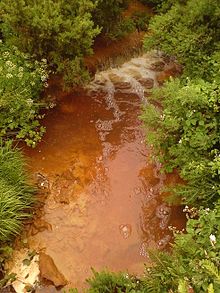
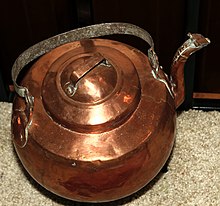
The
Copper is used in roofing,
During the rise in demand for copper for the Age of Electricity, from the 1880s until the Great Depression of the 1930s, the United States produced one third to half the world's newly mined copper.[116] Major districts included the Keweenaw district of northern Michigan, primarily native copper deposits, which was eclipsed by the vast sulphide deposits of Butte, Montana, in the late 1880s, which itself was eclipsed by porphyry deposits of the Southwest United States, especially at Bingham Canyon, Utah, and Morenci, Arizona. Introduction of open pit steam shovel mining and innovations in smelting, refining, flotation concentration and other processing steps led to mass production. Early in the twentieth century, Arizona ranked first, followed by Montana, then Utah and Michigan.[117]
Flash smelting was developed by Outokumpu in Finland and first applied at Harjavalta in 1949; the energy-efficient process accounts for 50% of the world's primary copper production.[118]
The Intergovernmental Council of Copper Exporting Countries, formed in 1967 by Chile, Peru, Zaire and Zambia, operated in the copper market as OPEC does in oil, though it never achieved the same influence, particularly because the second-largest producer, the United States, was never a member; it was dissolved in 1988.[119]
Applications

The major applications of copper are electrical wire (60%), roofing and plumbing (20%), and industrial machinery (15%). Copper is used mostly as a pure metal, but when greater hardness is required, it is put into such alloys as brass and bronze (5% of total use).[26] For more than two centuries, copper paint has been used on boat hulls to control the growth of plants and shellfish.[120] A small part of the copper supply is used for nutritional supplements and fungicides in agriculture.[62][121] Machining of copper is possible, although alloys are preferred for good machinability in creating intricate parts.
Wire and cable
Despite competition from other materials, copper remains the preferred
For a short period from the late 1960s to the late 1970s, copper wiring was replaced by

Electric motors
Copper's superior
Renewable energy production
Copper plays an important role in these renewable energy systems.
When choosing electrical conductors, facility planners and engineers factor capital investment costs of materials against operational savings due to their electrical energy efficiencies over their useful lives, plus maintenance costs. Copper often fares well in these calculations. A factor called "copper usage intensity,” is a measure of the quantity of copper necessary to install one megawatt of new power-generating capacity.

When planning for a new renewable power facility, engineers and product specifiers seek to avoid supply shortages of selected materials. According to the United States Geological Survey, in-ground copper reserves have increased more than 700% since 1950, from almost 100 million tonnes to 720 million tonnes in 2017, despite the fact that world refined usage has more than tripled in the last 50 years.[143] Copper resources are estimated to exceed 5,000 million tonnes.[144][145]
Bolstering the supply from copper extraction is the more than 30 percent of copper installed from 2007 to 2017 that came from recycled sources.[146] Its recycling rate is higher than any other metal.[147]Architecture



Copper has been used since ancient times as a durable,
The metal's distinctive natural green patina has long been coveted by architects and designers. The final patina is a particularly durable layer that is highly resistant to atmospheric corrosion, thereby protecting the underlying metal against further weathering.[152][153][154] It can be a mixture of carbonate and sulfate compounds in various amounts, depending upon environmental conditions such as sulfur-containing acid rain.[155][156][157][158] Architectural copper and its alloys can also be 'finished' to take on a particular look, feel, or color. Finishes include mechanical surface treatments, chemical coloring, and coatings.[159]
Copper has excellent
Antibiofouling
Copper is
Antimicrobial
Copper demand
Total world production in 2023 is expected to be almost 23 million
For some purposes, other metals can substitute,
Speculative investing
Copper may be used as a speculative investment due to the predicted increase in use from worldwide infrastructure growth, and the important role it has in producing
Folk medicine
Copper is commonly used in jewelry, and according to some folklore, copper bracelets relieve arthritis symptoms.[184] In one trial for osteoarthritis and one trial for rheumatoid arthritis, no differences were found between copper bracelet and control (non-copper) bracelet.[185][186] No evidence shows that copper can be absorbed through the skin. If it were, it might lead to copper poisoning.[187]
Degradation
Chromobacterium violaceum and Pseudomonas fluorescens can both mobilize solid copper as a cyanide compound.[188] The ericoid mycorrhizal fungi associated with Calluna, Erica and Vaccinium can grow in metalliferous soils containing copper.[188] The ectomycorrhizal fungus Suillus luteus protects young pine trees from copper toxicity. A sample of the fungus Aspergillus niger was found growing from gold mining solution and was found to contain cyano complexes of such metals as gold, silver, copper, iron, and zinc. The fungus also plays a role in the solubilization of heavy metal sulfides.[189]
Biological role

Biochemistry
- Cu2+-SOD + O2− → Cu+-SOD + O2 (reduction of copper; oxidation of superoxide)
- Cu+-SOD + O2− + 2H+ → Cu2+-SOD + H2O2 (oxidation of copper; reduction of superoxide)
The protein
A unique tetranuclear copper center has been found in nitrous-oxide reductase.[194]
Chemical compounds which were developed for treatment of Wilson's disease have been investigated for use in cancer therapy.[195]
Nutrition
Copper is an essential trace element in plants and animals, but not all microorganisms. The human body contains copper at a level of about 1.4 to 2.1 mg per kg of body mass.[196]
Absorption
Copper is absorbed in the gut, then transported to the liver bound to albumin.[197] After processing in the liver, copper is distributed to other tissues in a second phase, which involves the protein ceruloplasmin, carrying the majority of copper in blood. Ceruloplasmin also carries the copper that is excreted in milk, and is particularly well-absorbed as a copper source.[198] Copper in the body normally undergoes enterohepatic circulation (about 5 mg a day, vs. about 1 mg per day absorbed in the diet and excreted from the body), and the body is able to excrete some excess copper, if needed, via bile, which carries some copper out of the liver that is not then reabsorbed by the intestine.[199][200]
Dietary recommendations
The
The European Food Safety Authority (EFSA) refers to the collective set of information as Dietary Reference Values, with Population Reference Intake (PRI) instead of RDA, and Average Requirement instead of EAR. AI and UL defined the same as in United States. For women and men ages 18 and older the AIs are set at 1.3 and 1.6 mg/day, respectively. AIs for pregnancy and lactation is 1.5 mg/day. For children ages 1–17 years the AIs increase with age from 0.7 to 1.3 mg/day. These AIs are higher than the U.S. RDAs.[203] The European Food Safety Authority reviewed the same safety question and set its UL at 5 mg/day, which is half the U.S. value.[204]
For U.S. food and dietary supplement labeling purposes the amount in a serving is expressed as a percent of Daily Value (%DV). For copper labeling purposes 100% of the Daily Value was 2.0 mg, but as of May 27, 2016[update], it was revised to 0.9 mg to bring it into agreement with the RDA.[205][206] A table of the old and new adult daily values is provided at Reference Daily Intake.
Deficiency
Because of its role in facilitating iron uptake, copper deficiency can produce anemia-like symptoms, neutropenia, bone abnormalities, hypopigmentation, impaired growth, increased incidence of infections, osteoporosis, hyperthyroidism, and abnormalities in glucose and cholesterol metabolism. Conversely, Wilson's disease causes an accumulation of copper in body tissues.
Severe deficiency can be found by testing for low plasma or serum copper levels, low ceruloplasmin, and low red blood cell superoxide dismutase levels; these are not sensitive to marginal copper status. The "cytochrome c oxidase activity of leucocytes and platelets" has been stated as another factor in deficiency, but the results have not been confirmed by replication.[207]
Toxicity
Gram quantities of various copper salts have been taken in suicide attempts and produced acute copper toxicity in humans, possibly due to redox cycling and the generation of
Chronic copper toxicity does not normally occur in humans because of transport systems that regulate absorption and excretion. Autosomal recessive mutations in copper transport proteins can disable these systems, leading to Wilson's disease with copper accumulation and cirrhosis of the liver in persons who have inherited two defective genes.[196]
Elevated copper levels have also been linked to worsening symptoms of Alzheimer's disease.[213][214]
Human exposure
In the US, the
Copper is a constituent of
See also
- Copper in renewable energy
- Copper nanoparticle
- Erosion corrosion of copper water tubes
- List of countries by copper production
- Metal theft
- Anaconda Copper
- Antofagasta PLC
- Codelco
- El Boleo mine
- Grasberg mine
- Copper foil
References
- ^ "Standard Atomic Weights: Copper". CIAAW. 1969.
- ISSN 1365-3075.
- ^ ISBN 978-1-62708-155-9.
- PMID 23418750.
- ISBN 0-8493-0486-5. Archived from the original(PDF) on 3 March 2011.
- ISBN 0-8493-0464-4.
- .
- OCLC 25228234.
- ^ "Copper". Merriam-Webster Dictionary. 2018. Retrieved 22 August 2018.
- ^ Johnson, MD PhD, Larry E., ed. (2008). "Copper". Merck Manual Home Health Handbook. Merck Sharp & Dohme Corp., a subsidiary of Merck & Co., Inc. Archived from the original on 7 March 2016. Retrieved 7 April 2013.
- ^ "Copper in human health".
- ^ ISBN 978-3-527-28126-8. Retrieved 2 May 2011.
- ISBN 978-0-07-292194-6.
- ^ ISBN 978-0-8493-0485-9.
- ISBN 978-0-9624382-0-2.
- ISBN 978-0-665-46912-1.
- ^ Ramachandran, Harishankar (14 March 2007). "Why is Copper Red?" (PDF). IIT Madras. Retrieved 27 December 2022.
- ^ "Galvanic Corrosion". Corrosion Doctors. Retrieved 29 April 2011.
- ^ ISBN 978-0-203-97078-2.
- ^ "Copper.org: Education: Statue of Liberty: Reclothing the First Lady of Metals – Repair Concerns". Copper.org. Retrieved 11 April 2011.
- .
- ^
- ^ "Interactive Chart of Nuclides". National Nuclear Data Center. Archived from the original on 25 August 2013. Retrieved 8 April 2011.
- PMID 7989968.
- S2CID 14595800.
- ^ ISBN 978-0-19-850340-8. Retrieved 2 May 2011.
- ^ Rickwood, P. C. (1981). "The largest crystals" (PDF). American Mineralogist. 66: 885.
- ISBN 978-0-19-850340-8. Retrieved 2 May 2011.
- OCLC 886492996.
- ^ Randazzo, Ryan (19 June 2011). "A new method to harvest copper". Azcentral.com. Archived from the original on 21 February 2023. Retrieved 25 April 2014.
- PMID 16432205.
- ISBN 978-82-7701-119-6. Retrieved 8 February 2021.
- ^ a b Leonard, Andrew (3 March 2006). "Peak copper?". Salon. Retrieved 8 March 2022.
- ISBN 978-0-393-32831-8.
- JSTOR 2596347.
- ISSN 0013-0613. Retrieved 19 December 2023.
- ISBN 978-0-08-037941-8.
- ^ ISBN 9783527303854.
- doi:10.1016/j.hydromet.2006.05.001. Archived from the original(PDF) on 18 August 2011.
- .
- ^ International Seabed Authority. "Polymetallic Nodules" (PDF). International Seabed Authority. Archived from the original (PDF) on 23 October 2021. Retrieved 8 February 2021.
- ISBN 978-90-481-2903-4.
- ISBN 978-1-68144-329-4.
- ^ "International Copper Association". Archived from the original on 5 March 2012. Retrieved 22 July 2009.
- ^ "Overview of Recycled Copper" Copper.org. (25 August 2010). Retrieved on 8 November 2011.
- ^ "Les opportunités du recyclage du cuivre de haute pureté" [Opportunities for recycling high purity copper] (PDF) (in French). WeeeCycling. 17 May 2021.
- ^ "Annual Memory 2020" (PDF). Codelco. p. 109.
- ^ "Philippines: attention, terrain miné" [Philippines: attention, mined land] (in French). Amnesty International. 9 November 2016.
- PMID 28744684.
- US Mint. Retrieved 9 July 2019.[permanent dead link]
- ^ "Pride and skill – the 10-cent coin". Royal Canadian Mint. Retrieved 9 July 2019.
- ^ "Gold Jewellery Alloys". World Gold Council. Archived from the original on 14 April 2009. Retrieved 6 June 2009.
- ^ Balver Zinn Solder Sn97Cu3 Archived 7 July 2011 at the Wayback Machine. (PDF) . balverzinn.com. Retrieved on 8 November 2011.
- ^ Deane, D. V. "Modern Coinage Systems" (PDF). British Numismatic Society. Retrieved 1 July 2019.
- ^ "What is 90% Silver?". American Precious Metals Exchange (APMEX). Archived from the original on 28 July 2020. Retrieved 1 July 2019.
- ^ Corrosion Tests and Standards. ASTM International. 2005. p. 368.
- .
- ^ ISBN 978-0-12-352651-9.
- PMID 30698952.
- ISBN 978-0-19-965763-6.
- ISBN 978-0-08-037941-8.
- ^ ISBN 978-3-527-31604-5.
- ISBN 0-471-21503-1
- .
- ^ Deodhar, S., Huckaby, J., Delahoussaye, M. and DeCoster, M.A., 2014, August. High-aspect ratio bio-metallic nanocomposites for cellular interactions. In IOP Conference Series: Materials Science and Engineering (Vol. 64, No. 1, p. 012014). https://iopscience.iop.org/article/10.1088/1757-899X/64/1/012014/meta.
- ^ Kelly, K.C., Wasserman, J.R., Deodhar, S., Huckaby, J. and DeCoster, M.A., 2015. Generation of scalable, metallic high-aspect ratio nanocomposites in a biological liquid medium. Journal of Visualized Experiments, (101), p.e52901. https://www.jove.com/t/52901/generation-scalable-metallic-high-aspect-ratio-nanocomposites.
- ^ Karan, A., Darder, M., Kansakar, U., Norcross, Z. and DeCoster, M.A., 2018. Integration of a Copper-Containing Biohybrid (CuHARS) with Cellulose for Subsequent Degradation and Biomedical Control. International journal of environmental research and public health, 15(5), p.844. https://www.mdpi.com/1660-4601/15/5/844
- ^ Birk, James (3 April 2018). "Characteristic Reactions of Iron (Fe³⁺)". LibreText Chemistry. LibreText. Retrieved 3 May 2023.
- ISBN 978-3-527-29773-3.
- .
- PMID 17305399.
- doi:10.15227/orgsyn.064.0001. Archived from the original(PDF) on 19 June 2012.
- .
- .
- ^ G. Brauer, ed. (1963). "Potassium Cuprate (III)". Handbook of Preparative Inorganic Chemistry. Vol. 1 (2nd ed.). NY: Academic Press. p. 1015.
- PMID 16196062.
- PMID 14871148.
- PMID 14871149.
- PMID 11669966.
- ISBN 978-0-08-037941-8.
- PMID 22498623.
- .
- ^ A Timeline of Copper Technologies, Copper Development Association, https://www.copper.org/education/history/timeline/
- ^ a b "CSA – Discovery Guides, A Brief History of Copper". Csa.com. Archived from the original on 3 February 2015. Retrieved 12 September 2008.
- ISBN 978-0-313-33507-5.No primary source is given in that book.
- ^ "Copper". Elements.vanderkrogt.net. Retrieved 12 September 2008.
- ISBN 978-0-14-013642-5. Retrieved 21 December 2011.
- ^ Cowen, R. "Essays on Geology, History, and People: Chapter 3: Fire and Metals". Retrieved 7 July 2009.
- PMID 27843139.
- ISBN 9781841717159.
- ^ a b "CSA – Discovery Guides, A Brief History of Copper". CSA Discovery Guides. Archived from the original on 3 February 2015. Retrieved 29 April 2011.
- ^ S2CID 233029733.
- ^ Pleger, Thomas C. "A Brief Introduction to the Old Copper Complex of the Western Great Lakes: 4000–1000 BC", Proceedings of the Twenty-Seventh Annual Meeting of the Forest History Association of Wisconsin, Oconto, Wisconsin, 5 October 2002, pp. 10–18.
- ISBN 1-4384-2701-8.
- PMID 35472064.
- S2CID 233663403.
- ^ PMID 23621800.
- S2CID 134060339.
- ^ Dainian, Fan. Chinese Studies in the History and Philosophy of Science and Technology. p. 228.
- ^ Wallach, Joel. Epigenetics: The Death of the Genetic Theory of Disease Transmission.
- ^ Radivojević, Miljana; Rehren, Thilo (December 2013). "Tainted ores and the rise of tin bronzes in Eurasia, c. 6500 years ago". Antiquity Publications Ltd.
- ^ ISBN 978-0-203-19211-5.
- ISBN 9781136373794.
- JSTOR 2843960.
- S2CID 138178474.
- ^ Martin, Susan R. (1995). "The State of Our Knowledge About Ancient Copper Mining in Michigan". The Michigan Archaeologist. 41 (2–3): 119. Archived from the original on 7 February 2016.
- ^ ISSN 0305-4403.
- ^ S2CID 53068689.
- S2CID 176767223.
- S2CID 232346123.
- doi:10.1021/ma9904870. Archived from the original(PDF) on 29 September 2007.
- ISBN 978-1-86189-173-0.
- ^ "Gold: prices, facts, figures and research: A brief history of money". Retrieved 22 April 2011.
- ^ "Copper and Brass in Ships". Retrieved 6 September 2016.
- S2CID 138550311.
- ^ Gardner, E. D.; et al. (1938). Copper Mining in North America. Washington, D. C.: U. S. Bureau of Mines. Retrieved 19 March 2019.
- ISBN 0-8165-1817-3.
- ^ "Outokumpu Flash Smelting" (PDF). Outokumpu. p. 2. Archived from the original (PDF) on 24 July 2011.
- S2CID 154183817.
- ^ Ryck Lydecker. "Is Copper Bottom Paint Sinking?". BoatUS Magazine. Retrieved 3 June 2016.
- ^ "Copper". American Elements. 2008. Archived from the original on 8 June 2008. Retrieved 12 July 2008.
- ^ Pops, Horace, 2008, "Processing of wire from antiquity to the future", Wire Journal International, June, pp. 58–66
- ^ The Metallurgy of Copper Wire, http://www.litz-wire.com/pdf%20files/Metallurgy_Copper_Wire.pdf Archived 1 September 2013 at the Wayback Machine
- ^ Joseph, Günter, 1999, Copper: Its Trade, Manufacture, Use, and Environmental Status, edited by Kundig, Konrad J.A., ASM International, pp. 141–192 and pp. 331–375.
- ^ "Copper, Chemical Element – Overview, Discovery and naming, Physical properties, Chemical properties, Occurrence in nature, Isotopes". Chemistryexplained.com. Retrieved 16 October 2012.
- ^ Joseph, Günter, 1999, Copper: Its Trade, Manufacture, Use, and Environmental Status, edited by Kundig, Konrad J.A., ASM International, p.348
- ^ "Aluminum Wiring Hazards and Pre-Purchase Inspections". www.heimer.com. Archived from the original on 28 May 2016. Retrieved 3 June 2016.
- ^ "Accelerator: Waveguides (SLAC VVC)". SLAC Virtual Visitor Center. Retrieved 29 April 2011.
- ^ IE3 energy-saving motors, Engineer Live, http://www.engineerlive.com/Design-Engineer/Motors_and_Drives/IE3_energy-saving_motors/22687/
- ^ Energy‐efficiency policy opportunities for electric motor‐driven systems, International Energy Agency, 2011 Working Paper in the Energy Efficiency Series, by Paul Waide and Conrad U. Brunner, OECD/IEA 2011
- ^ Fuchsloch, J. and E.F. Brush, (2007), "Systematic Design Approach for a New Series of Ultra‐NEMA Premium Copper Rotor Motors", in EEMODS 2007 Conference Proceedings, 10–15 June, Beijing.
- ^ Copper motor rotor project; Copper Development Association; "Copper.org: Copper Motor Rotor Project". Archived from the original on 13 March 2012. Retrieved 7 November 2012.
- ^ NEMA Premium Motors, The Association of Electrical Equipment and Medical Imaging Manufacturers; "NEMA - NEMA Premium Motors". Archived from the original on 2 April 2010. Retrieved 12 October 2009.
- ^ "Renewables 2022 – Analysis". IEA. Retrieved 16 August 2023.
- ^ "REN21 Renewables Global Status Report". REN21. 14 June 2019. Retrieved 16 August 2023.
- ^ Will the Transition to Renewable Energy Be Paved in Copper?, Renewable Energy World; Jan 15, 2016; https://www.renewableenergyworld.com/articles/2016/01/will-the-transition-to-renewable-energy-be-paved-in-copper.html Archived 2018-06-22 at the Wayback Machine
- ^ García-Olivares, Antonio, Joaquim Ballabrera-Poy, Emili García-Ladona, and Antonio Turiel. A global renewable mix with proven technologies and common materials, Energy Policy, 41 (2012): 561-57, http://imedea.uib-csic.es/master/cambioglobal/Modulo_I_cod101601/Ballabrera_Diciembre_2011/Articulos/Garcia-Olivares.2011.pdf
- ^ "Energy saving - A kilo more of copper increases environmental performance by 100 to 1,000 times". Renewable Energy Magazine, at the heart of clean energy journalism. 14 April 2011. Retrieved 16 August 2023.
- ^ Copper at the core of renewable energies; European Copper Institute; European Copper Institute; 18 pages; http://www.eurocopper.org/files/presskit/press_kit_copper_in_renewables_final_29_10_2008.pdf Archived 2012-05-23 at the Wayback Machine
- ^ Copper in energy systems; Copper Development Association Inc.; http://www.copper.org/environment/green/energy.html Archived 2020-08-01 at the Wayback Machine
- ^ The Rise Of Solar: A Unique Opportunity For Copper; Solar Industry Magazine; April 2017; Zolaika Strong; https://issues.solarindustrymag.com/article/rise-solar-unique-opportunity-copper Archived 2022-10-30 at the Wayback Machine
- ^ Pops, Horace, 1995. Physical Metallurgy of Electrical Conductors, in Nonferrous Wire Handbook, Volume 3: Principles and Practice, The Wire Association International
- ^ The World Copper Factbook, 2017; http://www.icsg.org/index.php/component/jdownloads/finish/170/2462
- ^ Copper Mineral Commodity Summary (USGS, 2017) https://minerals.usgs.gov/minerals/pubs/commodity/copper/ mcs-2017-coppe.pdf
- ^ Global Mineral Resource Assessment (USGS, 2014) http://pubs.usgs.gov/fs/2014/3004/pdf/fs2014-3004.pdf
- ^ Long-Term Availability of Copper; International Copper Association; http://copperalliance.org/wordpress/wp-content/uploads/2018/02/ICA-long-term-availability-201802-A4-HR.pdf Archived 2018-06-29 at the Wayback Machine
- ^ Will the Transition to Renewable Energy Be Paved in Copper?, Renewable Energy World; Jan 15, 2016; by Zolaikha Strong; https://www.renewableenergyworld.com/articles/2016/01/will-the-transition-to-renewable-energy-be-paved-in-copper.html Archived 2018-06-22 at the Wayback Machine
- ^ Seale, Wayne (2007). The role of copper, brass, and bronze in architecture and design; Metal Architecture, May 2007
- ^ Copper roofing in detail; Copper in Architecture; Copper Development Association, U.K., www.cda.org.uk/arch
- ^ Architecture, European Copper Institute; http://eurocopper.org/copper/copper-architecture.html Archived 9 October 2012 at the Wayback Machine
- ^ Kronborg completed; Agency for Palaces and Cultural Properties, København, "Kronborg completed - Agency for Palaces and Cultural Properties". Archived from the original on 24 October 2012. Retrieved 12 September 2012.
- ^ Berg, Jan. "Why did we paint the library's roof?". Archived from the original on 25 June 2007. Retrieved 20 September 2007.
- ^ Architectural considerations; Copper in Architecture Design Handbook, http://www.copper.org/applications/architecture/arch_dhb/fundamentals/arch_considerations.htm[permanent dead link]
- ^ Peters, Larry E. (2004). Preventing corrosion on copper roofing systems; Professional Roofing, October 2004, http://www.professionalroofing.net
- ^ Wu, Chun. "Oxidation reaction: Why is the Statue of Liberty blue-green? How does rust work?" (PDF). wepanknowledgecenter.org. Engage Engineering. Archived from the original (PDF) on 25 October 2013. Retrieved 25 October 2013.
- .
- ^ Application Areas: Architecture – Finishes – patina; http://www.copper.org/applications/architecture/finishes.html
- ^ Glossary of copper terms, Copper Development Association (UK): "Glossary of copper terms". Archived from the original on 20 August 2012. Retrieved 14 September 2012.
- ^ Finishes – natural weathering; Copper in Architecture Design Handbook, Copper Development Association Inc., "Copper.org: Architecture Design Handbook: Finishes". Archived from the original on 16 October 2012. Retrieved 12 September 2012.
- ISBN 978-0-87170-726-0.
- ^ Edding, Mario E., Flores, Hector, and Miranda, Claudio, (1995), Experimental Usage of Copper-Nickel Alloy Mesh in Mariculture. Part 1: Feasibility of usage in a temperate zone; Part 2: Demonstration of usage in a cold zone; Final report to the International Copper Association Ltd.
- ^ Corrosion Behaviour of Copper Alloys used in Marine Aquaculture Archived 24 September 2013 at the Wayback Machine. (PDF) . copper.org. Retrieved on 8 November 2011.
- ^ Copper Touch Surfaces Archived 23 July 2012 at the Wayback Machine. Copper Touch Surfaces. Retrieved on 8 November 2011.
- ^ "EPA Registers Copper Surfaces for Residual Use Against Coronavirus". United States Environmental Protection Agency. 10 February 2021. Retrieved 11 October 2021.
- PMID 30627427.
- ^ a b "EPA registers copper-containing alloy products". United States Environmental Protection Agency. May 2008. Archived from the original on 29 September 2015.
- S2CID 32388649. Archived from the original(PDF) on 17 February 2019.
- ^ Zaleski, Andrew, As hospitals look to prevent infections, a chorus of researchers make a case for copper surfaces, STAT, 24 September 2020
- ^ Chilean subway protected with Antimicrobial Copper – Rail News from Archived 24 July 2012 at the Wayback Machine. rail.co. Retrieved on 8 November 2011.
- ^ Codelco to provide antimicrobial copper for new metro lines (Chile) [dead link]. Construpages.com.ve. Retrieved on 8 November 2011.
- ^ PR 811 Chilean Subway Installs Antimicrobial Copper Archived 23 November 2011 at the Wayback Machine. (PDF). antimicrobialcopper.com. Retrieved on 8 November 2011.
- ^ "Copper and Cupron". Cupron.
- ^ GlobalData (17 November 2023). "Global copper supply in 2023 will be supported by increased output from the DRC, Peru, and Chile". Mining Technology. Retrieved 22 December 2023.
- ^ Woods, Bob (27 September 2023). "Copper is critical to energy transition. The world is falling way behind on producing enough". CNBC. Retrieved 22 December 2023.
- ^ "China drives copper to 4-month low, raising global economic alarms". Nikkei Asia. Retrieved 22 December 2023.
- ^ "Repairing aluminum wiring" (PDF). U.S. Consumer Product Safety Commission. p. 1. Archived from the original (PDF) on 25 December 2016. Retrieved 23 December 2023.
A national survey conducted by Franklin Research Institute for CPSC showed that homes built before 1972, and wired with aluminum, are 55 times more likely to have one or more wire connections at outlets reach "Fire Hazard Conditions" than homes wired with copper.
- ^ Hellemans, Alexander (1 January 2007). "Manufacturing Mayday: Production glitches send Airbus into a tailspin". IEEE Spectrum. Retrieved 19 June 2014.
- ^ "Global copper market under supplied, demand on the rise – report". Mining.com. 6 January 2019. Retrieved 13 January 2019.
- ^ "Will the Transition to Renewable Energy Be Paved in Copper?". www.renewableenergyworld.com. 15 January 2015. Archived from the original on 22 June 2018. Retrieved 13 January 2019.
- ^ "Copper and cars: Boom goes beyond electric vehicles". MINING.com. 18 June 2018. Retrieved 13 January 2019.
- ^ "Impact of electric cars in medium-term copper demand 'overrated', experts say". MINING.com. 12 April 2018. Retrieved 13 January 2019.
- ^ "Why are Premiums for Copper Bullion So High?". Provident Metals. 20 August 2012. Retrieved 23 January 2019.
- ^ Chace, Zoe. "Penny Hoarders Hope for the Day The Penny Dies". NPR.org. NPR. Retrieved 23 January 2019.
- PMID 961545.
- PMID 24066023.
- PMID 19942103.
- ^ "Find the Truth Behind Medical Myths". University of Arkansas for Medical Sciences. 6 January 2014. Archived from the original on 6 January 2014.
While it's never been proven that copper can be absorbed through the skin by wearing a bracelet, research has shown that excessive copper can result in poisoning, causing vomiting and, in severe cases, liver damage.
- ^ PMID 20019082.
- ISBN 978-0-470-05058-3.
- ISSN 1868-0402
- ^ "Fun facts". Horseshoe crab. University of Delaware. Archived from the original on 22 October 2008. Retrieved 13 July 2008.
- ^ ISBN 0-935702-73-3.
- PMID 10821735.
- ^
Schneider, Lisa K.; Wüst, Anja; Pomowski, Anja; Zhang, Lin; Einsle, Oliver (2014). "No Laughing Matter: The Unmaking of the Greenhouse Gas Dinitrogen Monoxide by Nitrous Oxide Reductase". In Peter M.H. Kroneck; Martha E. Sosa Torres (eds.). The Metal-Driven Biogeochemistry of Gaseous Compounds in the Environment. Metal Ions in Life Sciences. Vol. 14. Springer. pp. 177–210. PMID 25416395.
- )
- ^ a b "Amount of copper in the normal human body, and other nutritional copper facts". Archived from the original on 10 April 2009. Retrieved 3 April 2009.
- PMID 13859394.
- PMID 9587137.
- PMID 775938.
- PMID 2301561.
- ^ Dietary Reference Intakes: RDA and AI for Vitamins and Elements Archived 13 November 2018 at the Wayback Machine Food and Nutrition Board, Institute of Medicine, National Academies Press, 2011. Retrieved 18 April 2018.
- ^ Copper. IN: Dietary Reference Intakes for Vitamin A, Vitamin K, Arsenic, Boron, Chromium, Copper, Iodine, Iron, Manganese, Molybdenum, Nickel, Silicon, Vanadium, and Copper. National Academy Press. 2001, PP. 224–257.
- ^ "Overview on Dietary Reference Values for the EU population as derived by the EFSA Panel on Dietetic Products, Nutrition and Allergies" (PDF). 2017.
- ^ Tolerable Upper Intake Levels For Vitamins And Minerals (PDF), European Food Safety Authority, 2006
- ^ "Federal Register May 27, 2016 Food Labeling: Revision of the Nutrition and Supplement Facts Labels. FR p. 33982" (PDF).
- ^ "Daily Value Reference of the Dietary Supplement Label Database (DSLD)". Dietary Supplement Label Database (DSLD). Archived from the original on 7 April 2020. Retrieved 16 May 2020.
- PMID 12010579.
- PMID 8033320.
- PMID 3514679.
- ^ "Pesticide Information Profile for Copper Sulfate". Cornell University. Retrieved 10 July 2008.
- PMID 5841854.
- hdl:10251/10503.
- S2CID 16989047.
- ^ "Copper: Alzheimer's Disease". Examine.com. Retrieved 21 June 2015.
- ^ NIOSH Pocket Guide to Chemical Hazards. "#0151". National Institute for Occupational Safety and Health (NIOSH).
- ^ NIOSH Pocket Guide to Chemical Hazards. "#0150". National Institute for Occupational Safety and Health (NIOSH).
- OEHHA Copper
- PMID 21556207.
- PMID 23493960.
- S2CID 35694266.
Notes
 |
 |
 |
 |
| in pure water, or acidic or alkali conditions. Copper in neutral water is more noble than hydrogen. | in water containing sulfide | in 10 M ammonia solution | in a chloride solution |
Further reading
- Massaro, Edward J., ed. (2002). Handbook of Copper Pharmacology and Toxicology. Humana Press. ISBN 978-0-89603-943-8.
- "Copper: Technology & Competitiveness (Summary) Chapter 6: Copper Production Technology" (PDF). Office of Technology Assessment. 2005.
- Current Medicinal Chemistry, Volume 12, Number 10, May 2005, pp. 1161–1208(48) Metals, Toxicity and Oxidative Stress
- William D. Callister (2003). Materials Science and Engineering: an Introduction (6th ed.). Wiley, New York. Table 6.1, p. 137. ISBN 978-0-471-73696-7.
- Material: Copper (Cu), bulk, MEMS and Nanotechnology Clearinghouse.
- Kim BE; Nevitt T; Thiele DJ (2008). "Mechanisms for copper acquisition, distribution and regulation". Nat. Chem. Biol. 4 (3): 176–85. PMID 18277979.
External links
- Copper at The Periodic Table of Videos(University of Nottingham)
- Copper and compounds fact sheet from the National Pollutant Inventory of Australia
- International Copper Association and the Copper Alliance, a business interest group
- Copper.org – official website of the Copper Development Association, a North American industry association with an extensive site of properties and uses of copper
- Price history of LME Copper, according to the IMF
